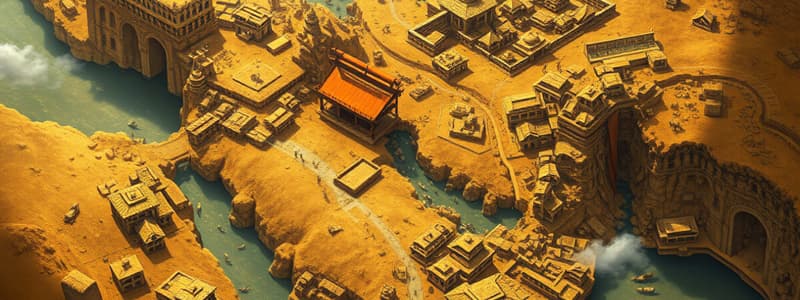Podcast
Questions and Answers
What was the purpose of developing flying cash in ancient China?
What was the purpose of developing flying cash in ancient China?
- To reduce the amount of gold and silver used in trade
- To standardize weights and measures in transactions
- To facilitate easier trade by allowing cash deposits and withdrawals (correct)
- To enable bartering with local merchants
What was the Hanseatic League's primary function during the 13th century?
What was the Hanseatic League's primary function during the 13th century?
- To create a unified military force against invading armies
- To establish a network for the safe passage of pilgrims
- To exchange currencies between European nations
- To monopolize and control trade in the North and Baltic Seas (correct)
What innovation did the banking houses in European cities in the 1300s utilize?
What innovation did the banking houses in European cities in the 1300s utilize?
- A system of barter that included goods like cowrie shells
- The establishment of interest rates on loans
- The use of bills of exchange for secure transactions (correct)
- The implementation of gold-backed currency
Which geographic areas did the Hanseatic League primarily operate within?
Which geographic areas did the Hanseatic League primarily operate within?
What was one result of the Crusades on European trade?
What was one result of the Crusades on European trade?
What significant effect contributed to the development of thriving cities along the Silk Roads?
What significant effect contributed to the development of thriving cities along the Silk Roads?
Which city served as a major crossroads for the trading routes of the Silk Roads?
Which city served as a major crossroads for the trading routes of the Silk Roads?
What type of cultural exchange occurred in Samarkand?
What type of cultural exchange occurred in Samarkand?
What was the primary purpose of caravanserai along the Silk Roads?
What was the primary purpose of caravanserai along the Silk Roads?
What type of goods was Kashgar particularly known for producing?
What type of goods was Kashgar particularly known for producing?
Which of the following statements about the development of the Silk Roads is correct?
Which of the following statements about the development of the Silk Roads is correct?
Which of the following crops was NOT mentioned as being cultivated in the lands around Kashgar?
Which of the following crops was NOT mentioned as being cultivated in the lands around Kashgar?
What role did the oasis cities play in the context of the Silk Roads?
What role did the oasis cities play in the context of the Silk Roads?
Flashcards are hidden until you start studying
Study Notes
Effects of the Growth of Exchange Networks
- Expansion of the Silk Roads led to the development of oases and thriving cities that became significant trade centers.
- Cities such as Kashgar, located at the crossroads of northern and southern Silk Road routes, flourished due to water resources from the Kashgar River, enabling agricultural productivity (wheat, rice, fruits, cotton).
- Kashgar's artisans produced textiles, rugs, leather goods, and pottery, creating a vibrant market and a blend of ideas and goods, leading to notable Islamic scholarship.
- Samarkand, situated in the Zeravshan River valley of Uzbekistan, served as a cultural and trading hub, showcasing diverse religious influences including Christianity, Buddhism, Zoroastrianism, and Islam.
- Samarkand was renowned for its artisans and centers of Islamic learning, housing intricately decorated mosques.
- Caravanserai, inns established about 100 miles apart, supported travelers and their animals, facilitating rest and trade along the arid Silk Roads.
- The term "caravanserai" comes from Persian words for caravan and palace, indicating their importance for transit and commerce.
Commercial Innovations
- China adapted its financial systems in response to increasing trade demands, transitioning from a cumbersome copper coin system to a more manageable credit system known as flying cash.
- Flying cash allowed merchants to deposit and withdraw paper money in different locations, laying groundwork for modern banking systems.
- The issuance of bills of exchange enabled traders to receive promised payments on specified dates, facilitating smoother financial transactions.
- The Crusades sparked European interest in Asian luxury goods, prompting organized trade of European resources.
- The Hanseatic League, formed in the 13th century by cities in northern Germany and Scandinavia, controlled trade in the North and Baltic Seas.
- Member cities like Lubeck, Hamburg, and Riga worked collectively to eliminate piracy and monopolize trade in essential goods such as timber, grain, leather, and salted fish.
- Hanseatic League ships navigated from the Baltic and North Seas to Mediterranean ports, enabling the exchange of valuable goods from Arab caravans.
- The League's dominance in trade persisted until the mid-17th century, when strengthening national governments eventually took over trade protection responsibilities.
Studying That Suits You
Use AI to generate personalized quizzes and flashcards to suit your learning preferences.



